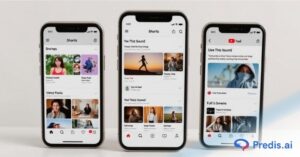Creating AI-generated videos is no longer the stuff of sci-fi. Today, businesses, content creators, and marketers can generate high-quality videos in minutes saving time, money, and resources. But here’s the thing: the output quality of AI videos depends heavily on your script and prompts. A vague prompt might give you a generic, robotic video, while a well-optimised script can produce engaging, professional-looking content that feels human.
Studies show that videos can increase understanding of products by 74%, and social media videos generate 1200% more shares than text and images combined. Imagine achieving that with AI-generated videos if your prompts and scripts are sharp enough.
In this guide, I’ll walk you through everything you need to know to optimise your scripts and prompts for better AI video outputs. We’ll also explore tools like Predis and how they make this process easier.
TL;DR 🖋
Creating high-quality AI videos starts with a clear, conversational script and a detailed prompt. Know your goal, audience, and desired style. Tools like Predis.ai help optimise scripts and predict performance, while platforms like Synthesia, Pictory, and InVideo make production easier. Test, refine, and focus on engagement to make your AI videos professional, relatable, and effective.
Understanding AI Video Generation
Before diving into scripts and prompts, it’s important to understand what actually happens behind the scenes. AI video tools aren’t magic, they’re sophisticated algorithms that take your instructions and transform them into visuals, audio, and animations. The more the AI understands your intentions, the better your final video will look. Knowing how these tools interpret scripts will help you craft instructions that actually work.
How AI Video Tools Work?
AI video tools convert text, prompts, or scripts into dynamic visual content. They analyse your instructions to generate:
- Voiceovers
- Animations or stock footage
- Captions and visual effects
- Background music
The clearer your input, the better your output. Think of it like giving directions: if you say “Take me to the shop,” you may end up anywhere. But if you specify the shop name, address, and timing, the journey is flawless.
Why Script + Prompt Quality Matters?
Your script is the foundation. Your prompt is the guide for the AI. Poor scripts often lead to:
- Generic visuals
- Robotic or mismatched voiceovers
- Lack of engagement
- Wasted time and credits
Optimising scripts and prompts ensures the AI video feels professional, natural, and relevant to your audience.
Preparing Your Script for AI Video Creation
Your script is the backbone of any AI-generated video. Think of it as the blueprint—if the foundation is shaky, the final video will feel off. Writing a script for AI is slightly different than writing for a human actor because you need to think about both voice and visuals. A strong script ensures the AI can translate your words into something engaging and professional.
1. Keep It Conversational
AI tools respond better to scripts that mimic real speech. Avoid overly formal or stiff sentences. Instead, write as if you’re explaining to a friend or client:
Example:
- Weak: “Our product improves efficiency in a business context.”
- Strong: “Want to save time at work? Our tool helps you get things done faster and smarter.”
2. Structure Matters
A well-structured script helps the AI visualise your content better. Use:
- Hook (0-10 sec): Grab attention immediately
- Body (10-45 sec): Explain benefits, features, or storytelling
- CTA (45-60 sec): Clear action for viewers
3. Include Visual & Tone Cues
AI video generators like Predis respond to cues. Mention:
- Visual style (cinematic, animated, realistic)
- Mood (fun, professional, motivational)
- Key scenes (product demo, talking-head, explainer graphics)
Example Prompt Addition:
“Use upbeat music, animated graphics for data, and cinematic close-ups of the product.”
4. Test & Refine Your Script
Don’t expect perfection on the first try. Run a test output, then tweak your wording, tone, or structure based on results. Predis and other AI video tools often allow iterative adjustments without starting from scratch.
Writing Effective Prompts for AI Videos
While the script provides the content, the prompt tells the AI how to present it. Prompts act like a director giving instructions to the AI: they influence style, tone, pacing, and visuals. A vague or poorly constructed prompt can result in generic, robotic output, so understanding how to craft effective prompts is key to producing high-quality videos.
1. What Makes a Good Prompt?
Prompts guide the AI on how to interpret your script. A strong prompt is:
- Specific (mention details)
- Contextual (explain the audience and purpose)
- Action-oriented (suggest tone, style, and transitions)
Example:
Weak: “Create a video about our app.”
Strong: “Create a 60-second upbeat video for social media showing how our app helps busy professionals organise tasks, with animated graphics and a friendly narrator voice.”
2. Include the Output Format in Your Prompt
Specify:
- Aspect ratio (16:9, 9:16, square)
- Duration (30 sec, 1 min, etc.)
- Style (minimalist, cinematic, realistic, cartoonish)
This ensures AI doesn’t guess, giving you consistent outputs for different platforms.
3. Leverage AI Features like Predis
Predis and similar tools provide advanced features like:
- Automated tone detection
- Predictive performance suggestions for scripts
- Prebuilt templates for marketing, explainer, or UGC-style videos
These features can help beginners who struggle with prompt writing by suggesting the right phrasing or structure.
Step-by-Step Guide to Optimising Script + Prompt
Creating high-quality AI videos doesn’t have to be overwhelming. By following a structured process, you can ensure your scripts and prompts guide the AI effectively, producing professional-looking videos that resonate with your audience. Let’s break it down step by step.
Step 1 – Define Your Goal
Before you type a single word or craft a prompt, ask yourself: what is the purpose of this video? Are you trying to educate your audience, promote a product, entertain, or simply inform? Defining the goal helps the AI prioritise tone, pacing, and visuals.
Next, decide on the call-to-action (CTA). Do you want viewers to buy, subscribe, share, or visit your website? Even a 30-second video needs a clear direction. The AI will follow your lead better when the goal is concrete.
Example:
If your goal is to explain a new app feature, your CTA could be: “Try the feature now—download our app today!” This gives your AI clear guidance on the closing scene.
Step 2 – Know Your Audience
Who is going to watch your video? Understanding your audience is critical. Consider:
- Age and interests: Younger audiences may prefer fast-paced, visually dynamic videos, while professionals may respond better to concise, informative content.
- Platforms: Instagram, TikTok, LinkedIn, or YouTube? Each has different video formats, lengths, and styles that work best.
- Pain points: What problem does your video solve? How can your content resonate with their needs or emotions?
Tip: Include audience context in your prompt. AI tools like Predis can even suggest styles and tones based on your target demographic.
Step 3 – Write a Conversational Script
AI responds best to scripts that mimic human speech. Keep sentences short, ideas clear, and avoid unnecessary jargon—unless your video is industry-specific.
Include visual cues in your script. For instance:
- “Show animated infographic of monthly sales growth”
- “Cut to a smiling user interacting with the app”
This helps the AI align visuals with your narrative, resulting in a more cohesive video.
Example:
Instead of writing:
“Our product enhances operational efficiency.”
Write:
“Want to get more done in less time? Our tool helps you work smarter and faster!”
Step 4 – Create a Detailed Prompt
Once your script is ready, craft a prompt that tells the AI exactly how to present it. Include:
- Style and tone: Cinematic, playful, motivational, professional
- Visuals: Animations, stock footage, talking-head clips, transitions
- Duration: 30 seconds, 1 minute, etc.
Also mention your audience context and desired outcome to ensure the AI creates a video that speaks directly to them.
Example Prompt:
“Create a 60-second upbeat social media video for small business owners. Show animated charts and happy customers, with a friendly narrator voice and cinematic music.”
Step 5 – Test, Review, and Refine
Never expect perfection on the first attempt. Generate a test video and watch carefully for:
- Mismatched visuals
- Awkward transitions
- Robotic voiceovers
Then tweak your script or prompt for clarity and rerun the AI. Iteration is key—small changes in phrasing or style cues can significantly improve the output.
Tip: Predis.ai makes this easier by predicting what script and prompt combinations perform best, reducing trial and error.
Tools and Platforms to Help You
Choosing the right AI video tool can save time, improve quality, and simplify the entire process. Here’s a breakdown of popular options, starting with one of the most beginner-friendly platforms.
1. Predis.ai
About:
Predis.ai is an AI video platform designed for marketers, content creators, and social media managers. It helps you optimise scripts and prompts while giving suggestions to improve engagement.
Features:
- Automated script optimisation suggestions
- UGC-style and social media video templates
- Voice and visual style selection
Why it Helps:
Predis is beginner-friendly and predicts which scripts and prompts will perform best. You don’t need advanced editing skills—just a clear script and prompt to get professional-looking videos.
Other Popular AI Video Tools
- Synthesia – Great for talking-head explainer videos. Ideal for training, tutorials, and corporate content.
- Pictory – Converts blogs or long-form text into engaging videos with minimal effort. Perfect for repurposing content.
- InVideo – Excellent for short, attention-grabbing social media videos with plenty of templates.
- Runway – AI-powered creative video editing for advanced effects, animations, and cinematic projects.
- Lumen5 – Turns articles or text into animated videos, ideal for content marketing campaigns.
Tip: Experiment with different platforms to see which fits your workflow and audience style best. Predis can even complement these tools by helping you refine scripts before exporting to another AI video platform.
Conclusion
Optimising your script and prompts is the key to producing high-quality AI videos that engage, inform, and convert. By following these strategies—keeping it conversational, adding clear prompts, using predictive tools like Predis, testing iterations—you can create professional AI videos even as a beginner.
Remember, AI is powerful, but the human touch in your script and prompt determines how well your story connects with viewers. Start small, test often, and refine your approach—your AI videos will improve with every iteration.















